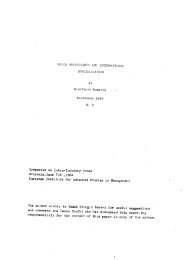BANDO DI SELEZIONE PER L'ATTRIBUZIONE DI ASSEGNI DI ...
BANDO DI SELEZIONE PER L'ATTRIBUZIONE DI ASSEGNI DI ...
BANDO DI SELEZIONE PER L'ATTRIBUZIONE DI ASSEGNI DI ...
Create successful ePaper yourself
Turn your PDF publications into a flip-book with our unique Google optimized e-Paper software.
<strong>DI</strong>PARTIMENTO <strong>DI</strong> SCIENZE ECONOMICHE<br />
systematic differences across the two groups. Given wage information over time we can<br />
also present estimates of the earnings change associated with displacement in order to<br />
establish the extent of any pecuniary costs of job displacement.<br />
The western literature on displacement suggests that there are 2 main reasons why there<br />
could be substantial earnings losses for displaced workers. First, if wages grow with<br />
seniority and experience at the firm, then these firm-specific wage premia will be foregone<br />
if workers lose their jobs and find work at a new firm where their wages will lack, initially,<br />
any element of rewards to firm-specific experience. In a restructuring transition economy, if<br />
these type of workers lose their jobs, their skills gained under the old order may not be in<br />
demand. A similar effect could be observed if there are wage premia associated with<br />
unionized jobs. Workers displaced from unionized jobs finding work in non-union jobs<br />
might expect to earn less, other things equal. Institutional features of the welfare state in the<br />
west can cushion job loss by providing unemployment income, job finding help and<br />
subsidized pay in return jobs. However in many transition economies, institutional help is<br />
less likely to be present and hence the ability to ameliorate the costs of job loss are limited<br />
and welfare support systems are rather under-developed and ungenerous, certainly in the<br />
two countries under study (Boeri and Terrell (2002)).<br />
Unions play a relatively minor role in the wage determination process in the two economies,<br />
so it is unlikely that this factor will have much importance. Many transition economies do<br />
however appear to retain elements of the “tariff ladders” from the planned era, which<br />
contain elements of seniority related pay. However, it might be that the nature of a transition<br />
economy, with more rapid restructuring and labor reallocation than in the West, (Davis and<br />
Haltiwanger (1999)), could create a sufficiently dynamic environment where job moves<br />
occur quickly without long intervening spells of unemployment and productivity levels in<br />
the new and restructured sectors offer relatively high wage prospects. In this case, the costs<br />
of job loss could be relatively low.<br />
As is often the case in transition economies, detailed empirical analysis is sometimes<br />
compromised by data availability and quality. However, within this project we will generate<br />
high quality data for Russia (via the displacement supplement to the RLFS) and will also<br />
use the ULMS data that have a very rich component on worker displacement. In addition we<br />
will perform post-displacement surveys of those workers that have left the three firms form<br />
which we will have personnel data. The opportunity to observe displacement in these two<br />
transition economies, where reforms have been relatively sporadic – in particular in Ukraine<br />
- generates more information about the displacement process, by comparing the incidence<br />
and consequences of displacement in these two countries that still are at a much earlier stage<br />
of the transition process than most Central European countries. This information can also be<br />
benchmarked against displacement patterns using comparable data sets from western<br />
economies.<br />
2. Existing Literature<br />
As yet, little empirical evidence on displaced workers exists for transition economies, The<br />
only two papers that we are aware of are Lehmann, Phillips and Wadsworth (2005) and<br />
Orazem, Vodopivec, and Wu (2002), which look at worker displacement in Estonia and<br />
Slovenia respectively (The studies that analyse the fate of German displaced workers, i.e.<br />
Burda and Mertens (1998), Couch (2001) and Bender et al. (2002), do not focus on Eastern



